The Hillbrink Codex: Hitler's Words in Propaganda
About The Banner
The photo on the left in the above banner is that of Herbert E. Hillbrink, an American soldier in the Counter Intelligence Corps at the time of the Nazi defeat and the end of World War II. He was the compiler and binder of the present volume as part of his duties during the Allied Occupation of Germany.
The other parts of the banner are from a few of the Nazi "Wochenspruch" series of popular weekly sayings by Hitler; a series of widely distributed wartime Nazi propaganda posters, of interest to scholars and historians immediately after the war and now.
A collection of original Nazi propaganda posters
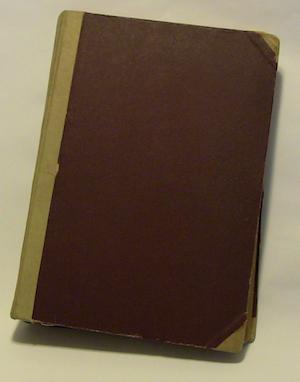
From the vantage point of the present, the Hillbrink Codex offers both insight into the propaganda fog surrounding the war-laden German people and at the same time insight into the activities that defined the Allied occupation of Germany at war's end. That is to say, the act of collecting these instances of propaganda says as much about Hitler's Germany as it does about the Allied interest in, perhaps even obsession with, the de-nazification of Germany after the war.
Long before Allied military actions in Africa and Europe began to turn the tide of Nazi fortunes, the Allies had planned to occupy and to govern Germany once the German army was destroyed. A constant flow of officers and men were being trained to take over the administration of captured areas so that local government, industry, agriculture and all that had been destroyed in war could be restored. This was necessary in the first place simply to exercise control over areas to the rear of front lines so that material and signal communications could operate to support the front lines.
At the same time many men were trained, as was Herbert Hillbrink, in counter intelligence to investigate and police captured areas, arrest enemy soldiers in civilian clothing, for example, and to process collaborators and displaced persons. In this way underground activities could be controlled, if not eliminated, so that rear areas could not threaten the peace once restored.
The Allied occupation of Germany was of a similar nature but writ large and with a view to the de-nazification of the country and the restoration of democracy. The unconditional surrender of Germany made this goal possible.

Herbert Hillbrink was appointed Special Branch Officer, in July 1946, at the Military Government Building at 42 Marktstrasse, Backnang, the former NSDAP Kreisleitung, or county government headquarters. This former Nazi government building, as Hillbrink points out in his preface, contained a great number of documents including this series of Wochenspruch weekly Nazi propaganda posters.
At the same time, the Allied Control Council had ordered the confiscation of all Nazi materials that could be construed as anti-democratic and possibly contributing to the development or maintenance of war potential: See "Order No. 4, Confiscation of Literature and Material of Nazi and Militarist Nature" Page 1, Page 2. An amendment to this order was made to allow for the preservation of a limited number of documents for the purpose of scholarship. See Order # 4 Amendment. The result of this amendment is this present volume. The amendment allowed German scholars to have access to these materials, but only under Allied supervision.
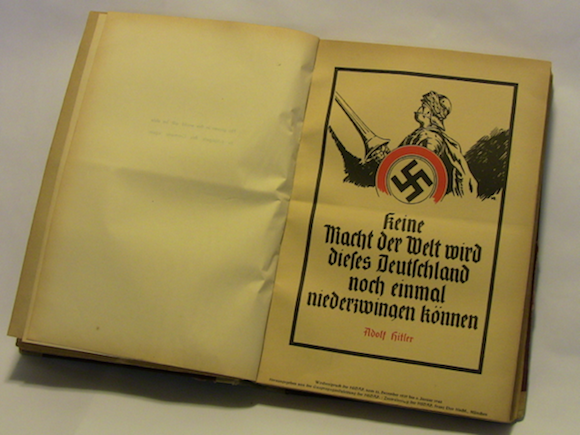

Hillbrink's Foreword
From the first days of the Occupation of Germany by the Allied Forces in 1944, a prearranged plan for the removal of Nazi Party (National-Sozialistische Deutscher Arbeiter Partei) influence went into effect.
The major task was to locate and intern those members of the Nazi Party known as the "Leadership Corps." Decency demanded the incarceration for future trail of the high ranking leaders of the German Political Party whose aims brought chaos and misery to millions of human beings. In the execution of this assignment there fell also to the Allied Forces especially trained for that type work the job of removing and excluding from positions of influence that section of German population who were minor leaders or members of the Nazi Party.
In the search for evidence of overzealous and extreme Nazi activity on the part of specific persons, tons of German confidential documents, files, records and propaganda material were gathered and evaluated.
Of the many forms of printed propaganda material seized, one of the best to have been discovered was the multicolored "Weekly Proverb" (Wochenspruch) Poster. Even as late as October 1947, such propaganda material was discovered in the archives of the Government of Backnang County (Kreis Backnang) in Württemberg-Baden.
The Posters incorporated in this binding were a part of the material seized above. Of necessity, only those are included which have been constructed around a phrase or paragraph uttered by the former Leader of the German Reich, Adolf Hitler.
The translations into English of the German Posters, have been made in the spirit and meaning of their time, in the true Nazi sense; thus, a literal translation in many instances was not possible.
Herbert E. Hillbrink
Backnang, Germany
April 1948


[Page 15]
The Posters
1939

[27 August - 2 September 1939. Page 23, Poster 1]
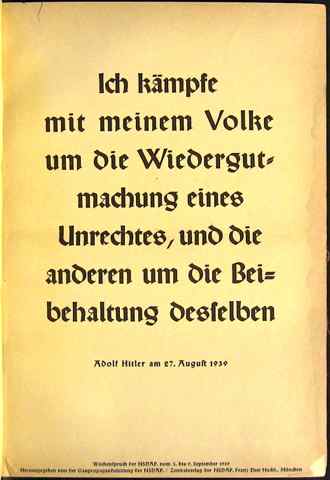
[3-9 September 1939. Page 27, Poster 2]
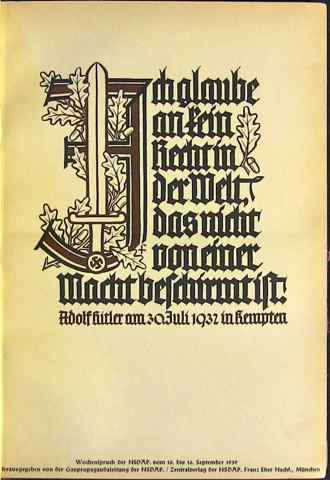
[10-16 September 1939. Page 31, Poster 3]

[24-30 September 1939. Page 35, Poster 4]

[1-7 October 1939. Page 39, Poster 5]
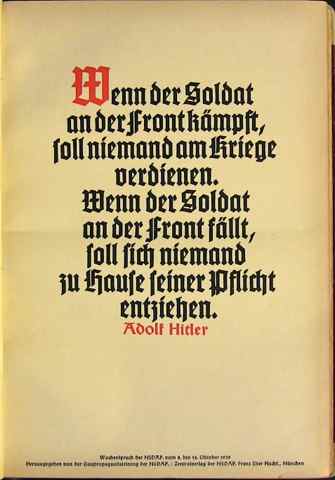
[8-14 October 1939. Page 43, Poster 6]

[15-21 October 1939. Page 47, Poster 7]
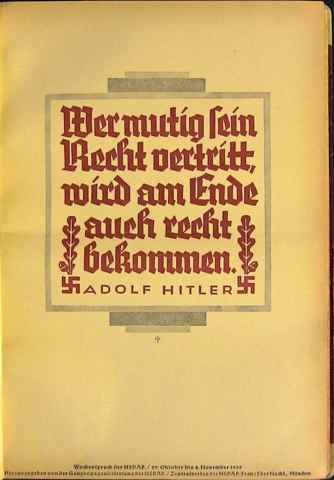
[29 October - 4 November 1939. Page 51, Poster 8]

[12-18 November 1939. Page 55, Poster 9]

[19-25 November 1939. Page 59, Poster 10]

[26 November - 2 December 1939. Page 63, Poster 11]

[10-16 December 1939. Page 67, Poster 12]

[17-23 December 1939. Page 71, Poster 13]
1940
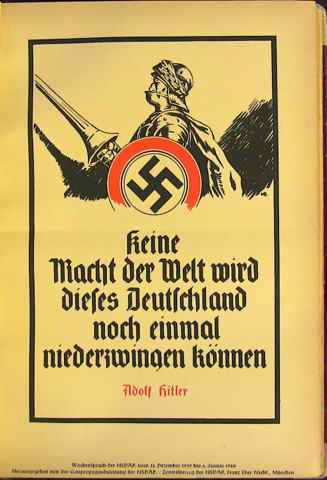
[31 December 1939 - 6 January 1940. Page 77, Poster 14]
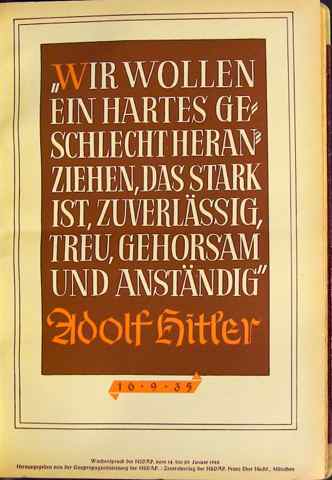
[14-20 January 1940. Page 81, Poster 15]

[21-27 January 1940. Page 85, Poster 16]

[28 January - 3 February 1940. Page 89, Poster 17]
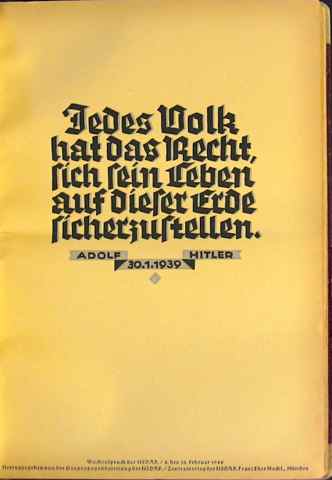
[4-10 February 1940. Page 93, Poster 18]
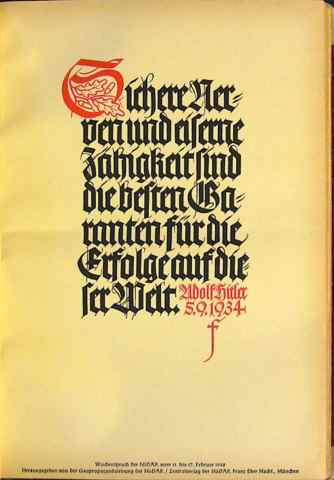
[11-17 February 1940. Page 97, Poster 19]

[18-24 February 1940. Page 101, Poster 20]

[3-9 March 1940. Page 105, Poster 21]
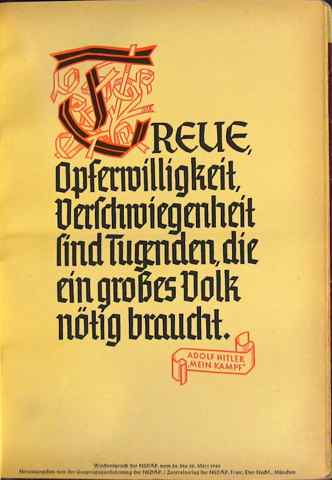
[24-30 March 1940. Page 109, Poster 22]

[7-13 April 1940. Page 113, Poster 23]
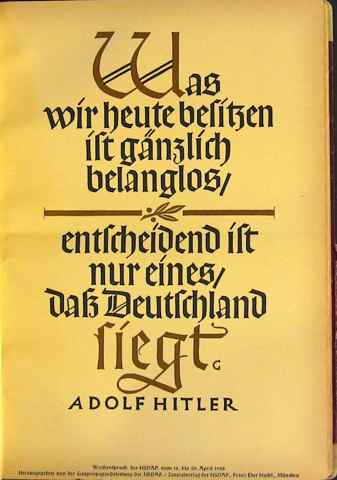
[14-20 April 1940. Page 117, Poster 24]

[21-27 April 1940. Page 121, Poster 25]
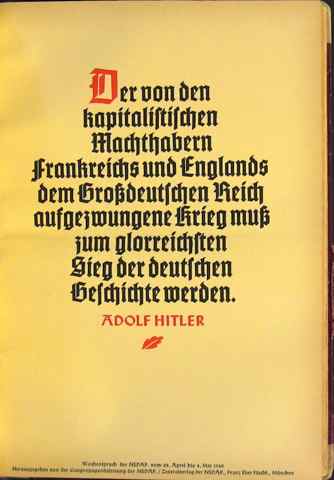
[28 April - 4 May 1940. Page 125, Poster 26]
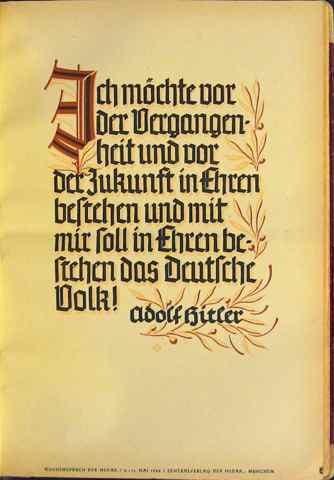
[5-11 May 1940. Page 129, Poster 27]

[12-18 May 1940. Page 133, Poster 28]

[26 May - 1 June 1940. Page 137, Poster 29]

[2-8 June 1940. Page 141, Poster 30]

[19-15 June 1940. Page 145, Poster 31]

[30 June - 6 July 1940. Page 149 Poster 32]

[21-27 July 1940. Page 153, Poster 33]

[28 July - 3 August 1940. Page 157, Poster 34]

[29 September - 5 October 1940. Page 161, Poster 35]

[17-23 Nomember 1940. Page 165, Poster 36]

[22-28 December 1940, Page 169, Poster 37]
1941
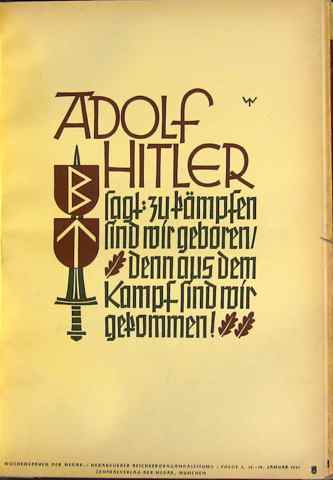
[12-18 January 1941. Page 175, Poster 38]

[19-25 January 1941. Page 179, Poster 39]
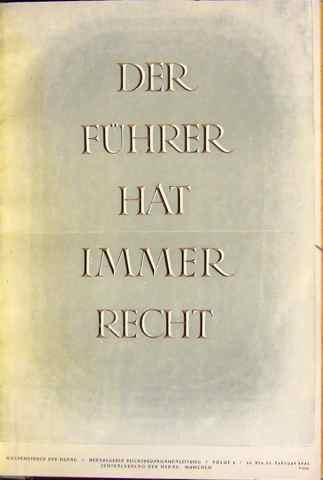
[16-22 February 1941. Page 183, Poster 40]

[23-29 March 1941. Page 187, Poster 41]
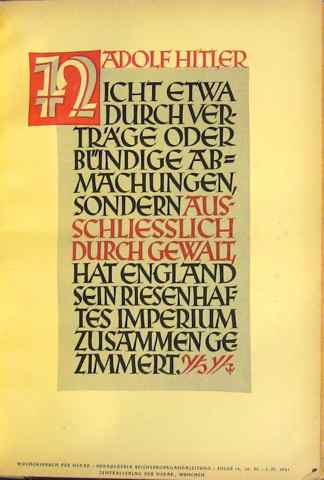
[30 March - 5 April 1941. Page 191, Poster 42]

[13-19 April 1941. Page 195, Poster 43]
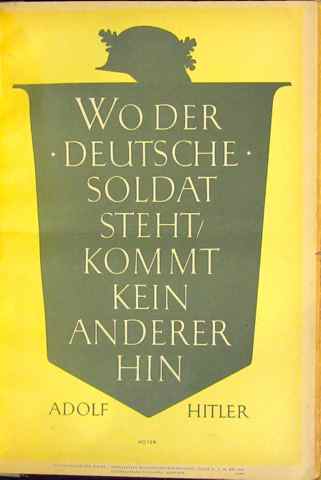
[4-10 May 1941. Page 199, Poster 44]

[11-17 May 1941. Page 203, Poster 45]

[18-24 May 1941. Page 207, Poster 46]
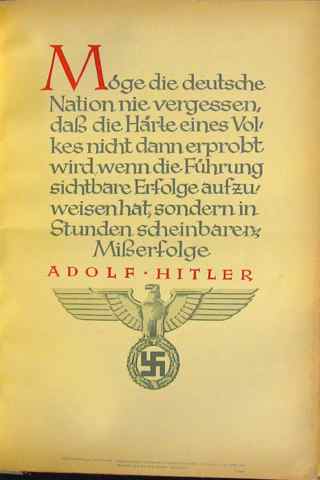
[7-13 June 1942. Page 211, Poster 47]

[22-28 June 1941. Page 215, Poster 48]

[6-12 July 1941. Page 219, Poster 49]

[20-26 July 1941. Page 223, Poster 50]

[31 august - 6 September 1941. Page 227, Poster 51]
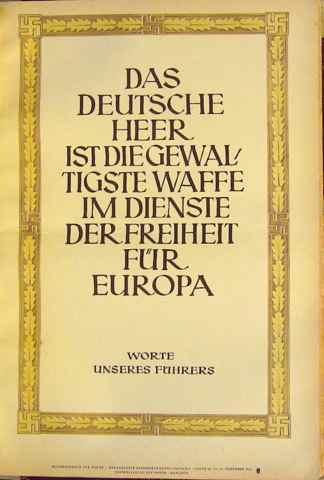
[21-27 September 1941. Page 231, Poster 52]

[9-15 November 1941. Page 235, Poster 53]
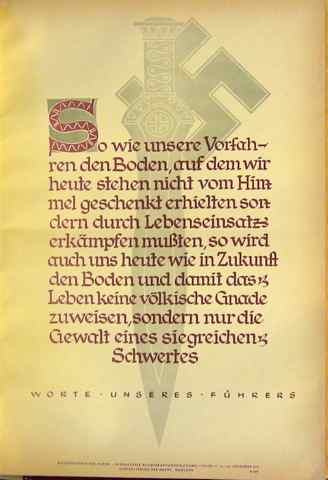
[16-22 November 1941. Page 239, Poster 54]

[23-29 November 1941. Page 243, Poster 55]

[7-13 December 1941. Page 247, Poster 56]
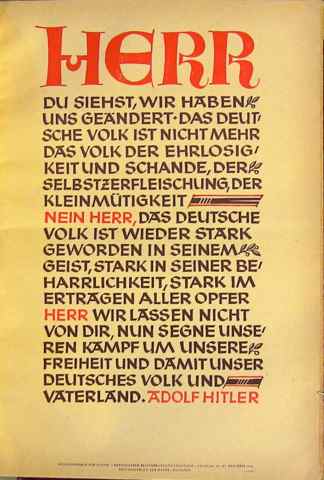
You see we have changed ourselves. The German People are no longer the Honorless and Shameless People of Self-Decimation and Weakness. No God! The German People have become strong again in Spirit, in Endurance, strong in the Sustaining of Sacrifice. God! We will not leave You! Bless our Battle for Freedom and therewith our People and Fatherland.
[21-27 December 1941. Page 251, Poster 57]
1942
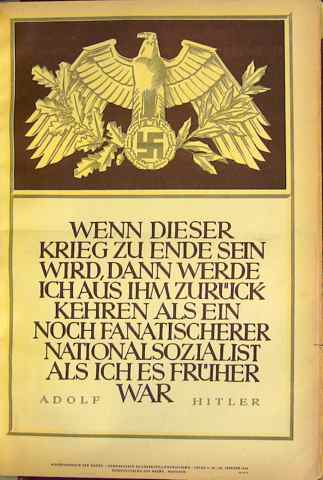
[22-28 February 1942. Page 257, Poster 58]

[15-21 March 1942. Page 261, Poster 59]
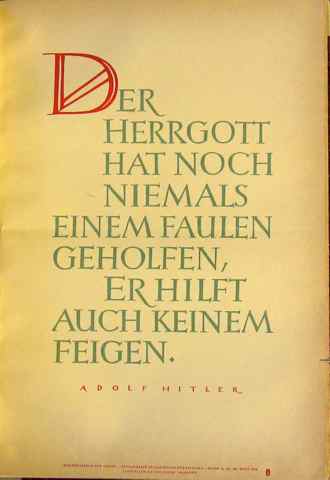
[22-28 March 1942. Page 265, Poster 60]
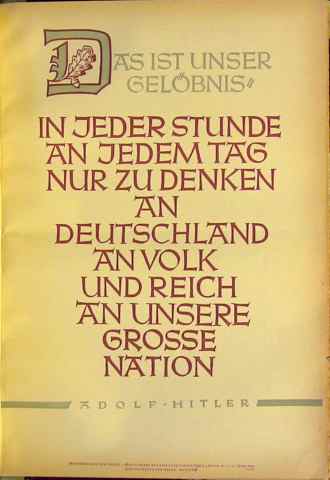
In every hour of every day to think only of Germany, of the People and State, and or our great Nation.
[5-11 April 1942. Page 269, Poster 61]
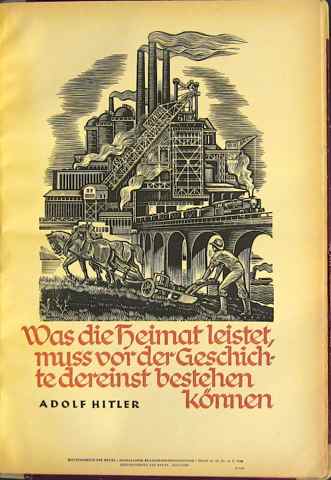
[26 April - 2 May 1942. Page 273, Poster 62]

[10-16 May 1942. Page 227, Poster 63]
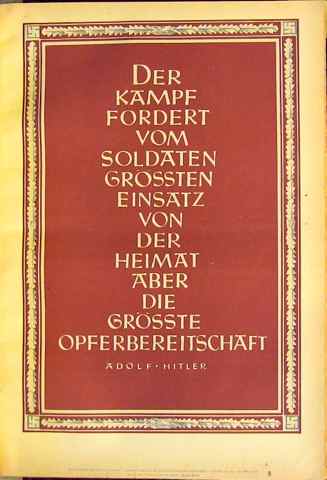
[24-30 May 1942. Page 281, Poster 64]

[14-20 June 1942. Page 285, Poster 65]
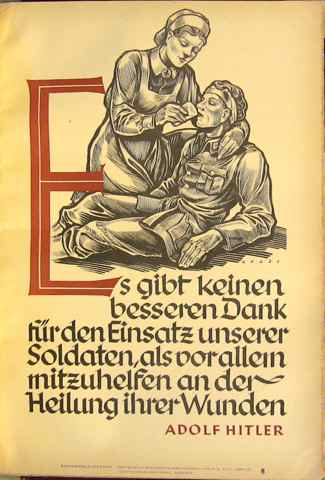
[21-27 June 1942. Page 289, Poster 66]

[5-11 July 1942. Page 293, Poster 67]

[26 July - 1 August 1942. Page 297, Poster 68]

[2-8 August 1942. Page 301, Poster 69]
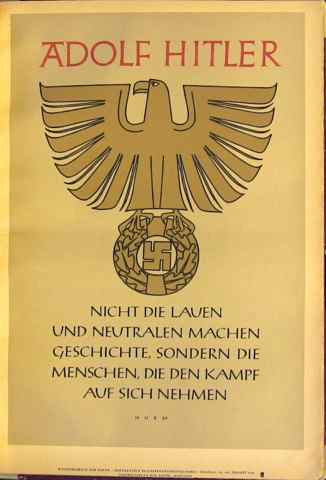
[23-29 August 1942. Page 305, Poster 70]

[20-26 September 1942. Page 309, Poster 71]

[4-10 October 1942. Page 313, Poster 72]
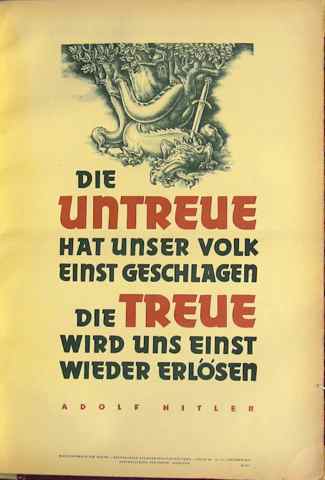
[11-17 October 1942. Page 317, Poster 73]

[2-8 November 1942. Page 321, Poster 74]
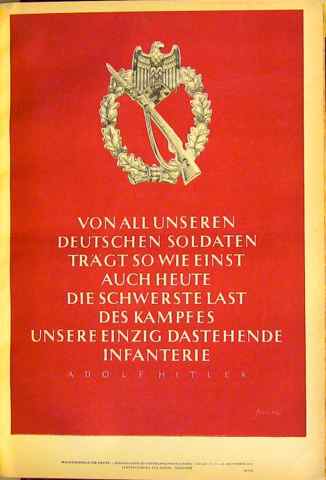
[15-21 November 1942. Page 325, Poster 75]

[29 November - 5 December 1942. Page 329, Poster 76]
1943

[25-31 January 1943. Page 335, Poster 77]

[14-21 February 1943. Page 339, Poster 78]

[26 April - 9 May 1943. Page 343, Poster 79]

[6-26 June 1943. Page 347 Poster 80]
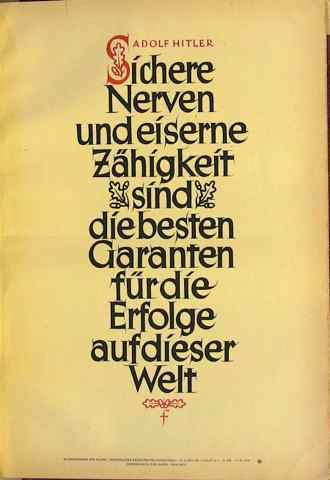
[28 August - 11 September 1943. Page 351, Poster 81]

[19-25 September 1943. Page 355, Poster 82]

[10-16 October 1943. Page 359, Poster 83]
1944

[6-12 February 1944. Page 365, Poster 84]
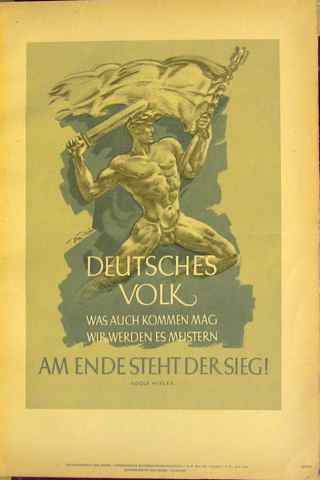
Come what may, we will master it. In the end, Victory will be ours!
[13-19 February 1944. Page 369, Poster 85]
